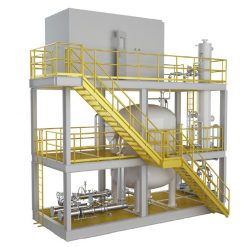Overview – BILECTRIC HF High-frequency AC desalter
-
Desalt challenging crude slates such as low-API and conductive crude oil
The BILECTRIC HF AC desalter begins the desalting process by adding low-salinity washwater upstream of the mixing valve, generating a uniform mixture of small-size brine and washwater droplets throughout the crude slate.
Next, the wet crude slate is spread between the electrodes by the unique fluid distribution system incorporating dual distributor heads. The rapid coalescence of the brine and washwater droplets in the high-voltage electrostatic fields between the three electrodes provides effective mixing and droplet growth.
Finally, gravity settles the resultant water droplets in the desalter vessel.
-
Efficient desalting provides numerous advantages that reduce opex and capex
- High operating interface level lengthens water residence, resulting in better water outlet quality.
- Improved water droplet coalescence and emulsion resolution lowers basic sediment and water (BS&W) and pounds of salt per thousand barrels (PTB) of treated crude.
- Lower demulsifier dosage decreases opex.
- Improved mixing of water droplets reduces washwater usage.
- Separate power units for each energized electrode reduce operational impact should a power unit or electrical component be lost.
- The unique three-grid design—two top grids performing coalescence while the lower grid conducts interface resolution—improves overall desalter performance.
- Rag control and rag elimination using the rag buster routine in the NATCO LRC-II smart interface increases uptime.
- The LRC-II interface makes faster process recovery after upsets and higher desalter availability more attainable.
Application of BILECTRIC HF High-frequency AC desalter
Upgrading to the BILECTRIC HF desalter can be performed without the need for vessel entry because all upgrades are done only to the power supply and control. The upgrade includes
- high-frequency power unit
- three-phase power supply
- LRC-II smart interface
- control wiring from the LRC-II smart interface to the BILECTRIC HF desalter power unit
- improved entrance bushing.
In electrostatic desalting, the crude oil is thoroughly mixed with freshwater in the mix valve to create uniform-size water droplets.The higher electrostatic force from the BILECTRIC HF AC desalter power unit creates improved coalescence of brine and freshwater droplets and growth of these droplets. These larger droplets of reduced salinity separate faster from the crude oil, and thus an improved desalting is achieved.The BILECTRIC HF desalter enables a higher operating pressure and offers an improved entrance bushing to handle the higher power from the high-frequency power unit. The upgraded entrance bushing can be installed without vessel entry through nozzles with a 2-in interior diameter and larger. With the LRC-II smart interface, the operational parameters of the BILECTRIC HF power unit can be adjusted while the desalter isoperating, eliminating costly process shutdowns for parameter changes. The operational parameters include base and modulation frequency and power unit secondary voltage.
Project Reference
Brochure
Download









